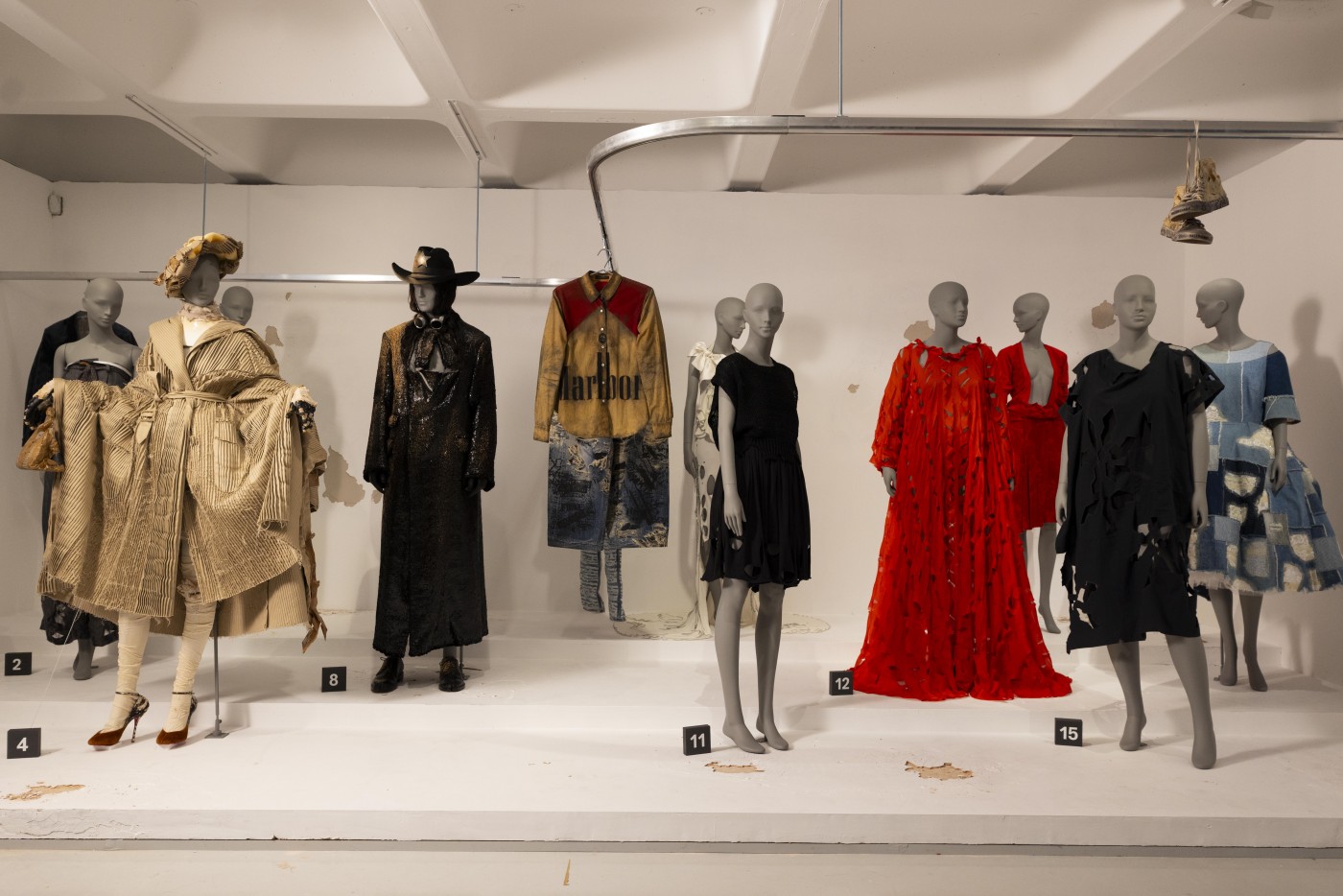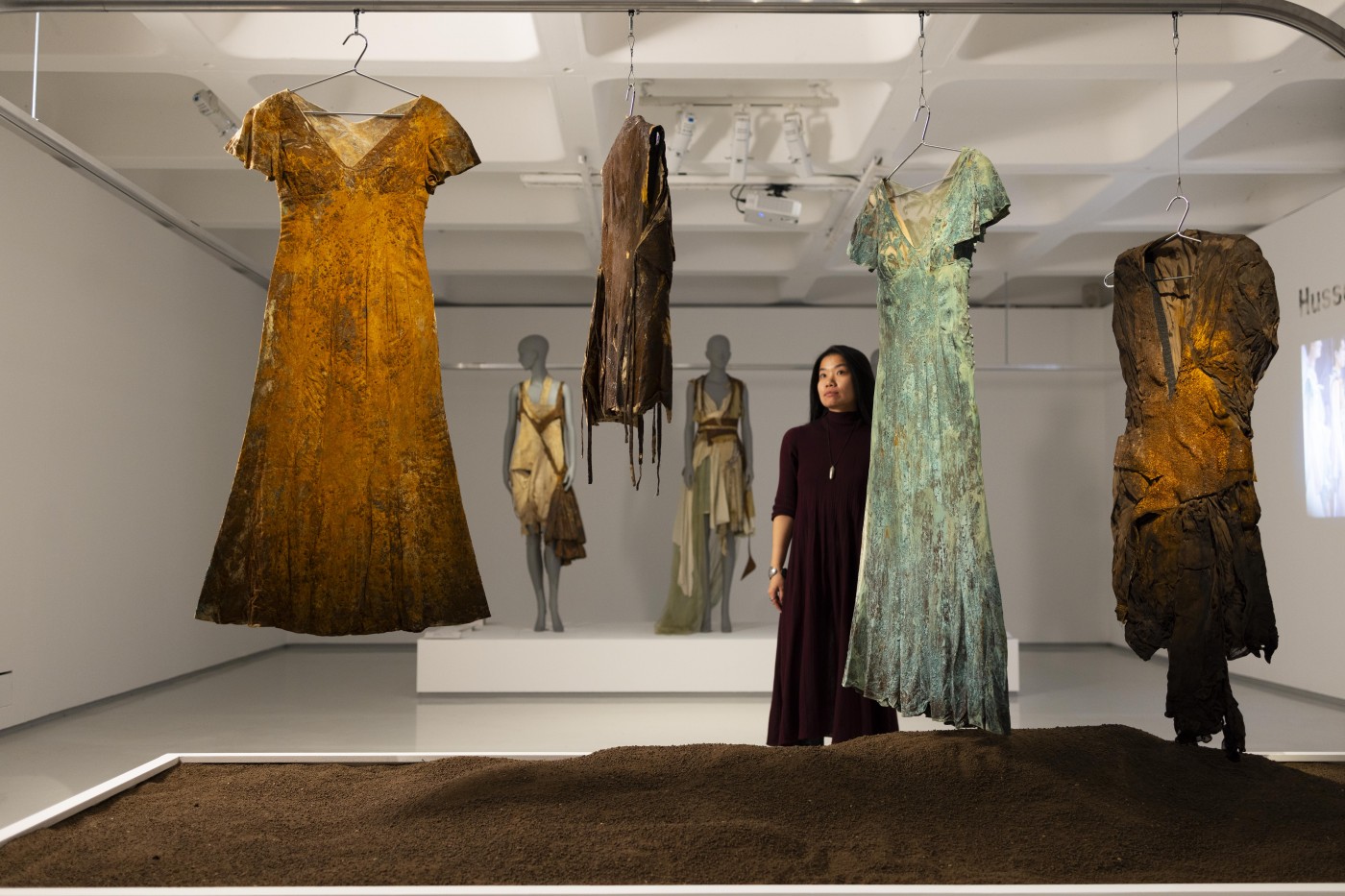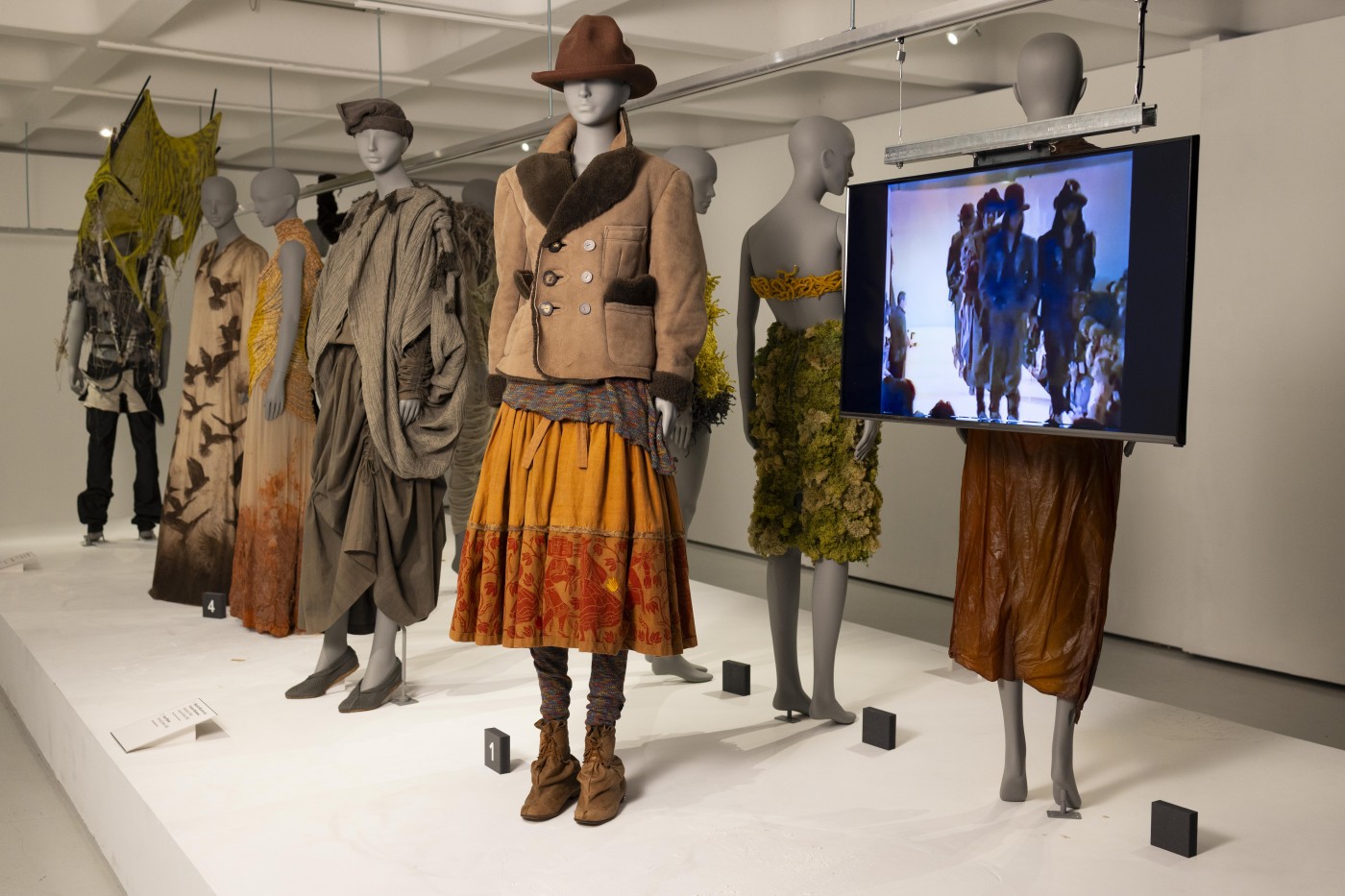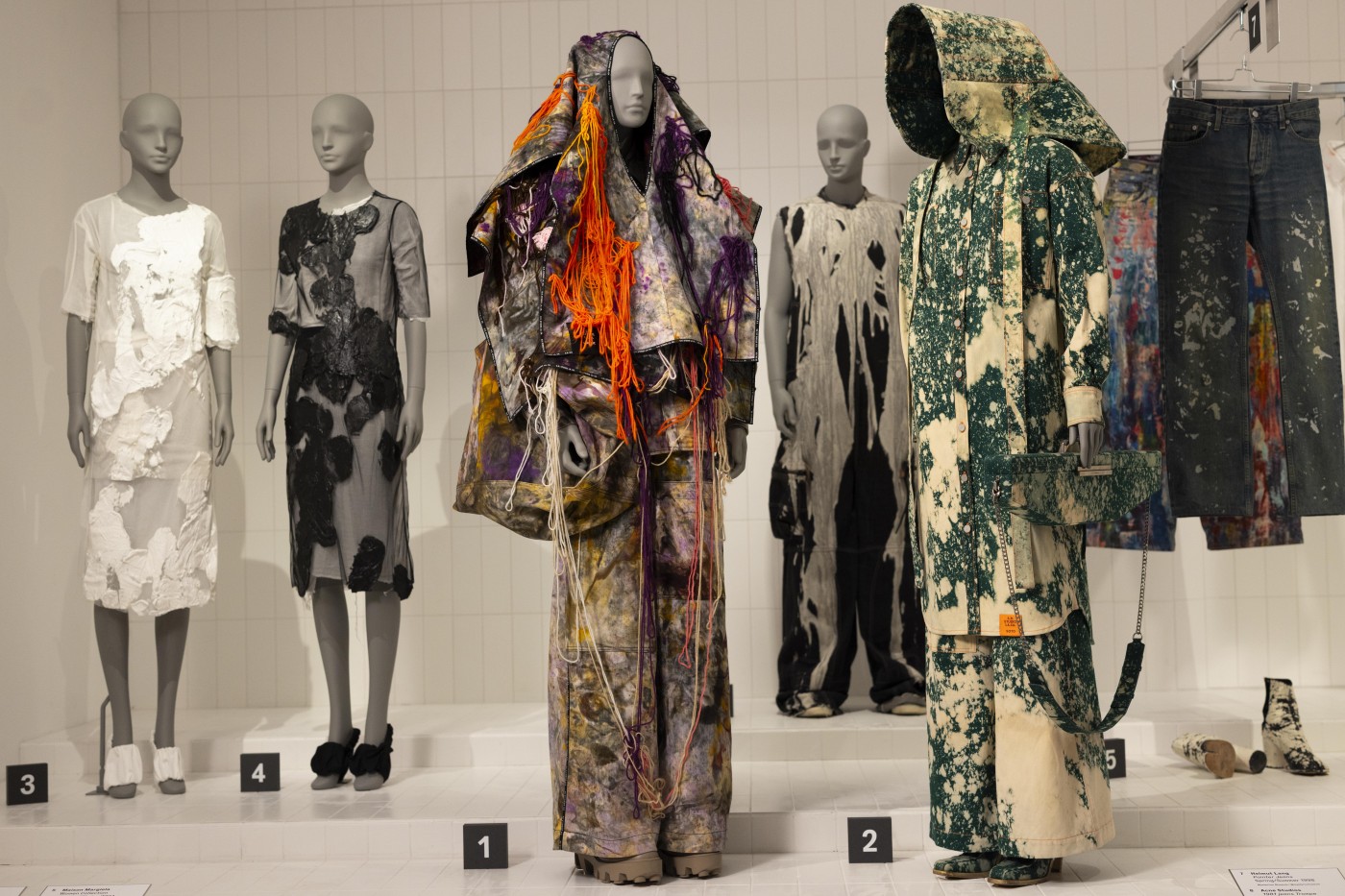- youtube
- bluesky
- Home
- About
- Costume Journal
- Membership
- Conference & Events
- Grants & Awards
- News & Social
In this week’s blog post, Costume Society member Jane Francis reviews the Barbican's Dirty Looks exhibition.
Stepping into the iconic grey brutalist architecture of London’s Barbican Centre Art Gallery, I dropped by the new exhibition Dirty Looks: Desire and Decay in Fashion. The building’s exposed, roughly textured concrete construction offers an uncannily fitting context for a show that quite literally revels in material breakdown.
Dirty Looks presents a rebellious and compelling exploration of how dirt, wear, rupture and material transformation have become powerful strategies in both contemporary and historic fashion practice. The exhibition asks us to consider what this desire for decay tells us about ourselves — and about the state of fashion today.
Anthropologist Mary Douglas famously describes dirt as “matter out of place”. Fashion has long been defined by glamorous, controlled surfaces that resist pollution and imperfection. Yet over the past fifty years, both real and simulated dirt have seeped into fashion, symbolising rebellion, romanticism and decay, as well as ideas of transience, spirituality and regeneration.

Dirty Looks Installation view. Barbican Art Gallery Thu 25 Sep 2025—Sun 25 Jan 2026© David Parry/Barbican Art Gallery
Curated by Karen Van Godtsenhoven and Jon Astbury, Dirty Looks draws visitors through a sequence of darkening, fractured gallery spaces where surfaces crack, lighting deepens and garments emerge like archaeological artefacts suspended in time. Van Godtsenhoven explains that she wants the exhibition “to make people question what they are wearing, what they see in fashion, but also their own presumptions about beauty and dirt, and how maybe dirt can be a liberator for us going forward.”
The show poses critical questions: Why has fashion begun to embrace mess, ruin, decay? And what might that reveal about our obsession with consumption, disposability and luxury? Here dirt becomes a form of critique — a challenge to mass-fashion’s glossy sheen, to sanitised beauty ideals and to the environmental waste embedded in the industry.
Featuring more than 120 garments by over 60 designers, from the late 1970s to the present, the exhibition reframes dirt not as damage but as a material witness — showing how garments record bodies, landscapes, labour and time. As Van Godtsenhoven notes: “Dirt is a very effective way of bringing back an idea of realness, about disrupting a form of order, what we deem acceptable.”
The journey is immersive and increasingly unsettling. The rooms move from relatively familiar garments to more radical terrain: decomposition, invisibility, delicate shreds, and clothing that is literally falling apart. Themes unfold across sections such as Hussein Chalayan: Future Archaeology; Nostalgia of Mud; Romantic Ruins; Spectres of Dirt; Stains as Ornament; Leaky Bodies; Glittering Debris; and Ma Ke: The Earth. Astbury, speaking to Wallpaper*, observes: “One thing that unites a lot of these designers is that they don’t think about what they do as fashion design just for the selling of clothes.”

Hussain Chalyan 1993-2002-Dirty Looks Installation view. Barbican Art Gallery Thu 25 Sep 2025—Sun 25 Jan 2026© David Parry/Barbican Art Gallery
The opening section, Hussein Chalayan’s Future Archaeology (1993–2002), is a powerful beginning. Chalayan’s seminal The Tangent Flows collection features garments buried underground, exhumed and presented with stains and oxidised surfaces. The pieces were first shown at his graduate show at Central Saint Martins in 1993. I have long been an admirer of his intellectual approach and was eager to see this work.
As he explains: “I went into fashion because I am very excited about the body. … For me, things are never as exciting if they don’t connect with experience, physicality, or thought.” (liatbrandel.com).
His pieces, combining silk, cotton and iron filings to instigate oxidation, achieve a haunting beauty — fragile, faded, yet conceptually potent. They blur the boundaries between clothing, time and archaeology
Chalayan is telling stories, he is exploring how time alters fabric just as identity and culture do… a theme that resonates throughout his practice.
This spirit of material ruination continues through Shelly Fox, whose blow-torched sequins, scorched Elastoplast and devoré shredding (1999–2003) echo Chalayan’s archaeology of damage. Fox writes: “Ruination is a word that best describes many aspects of my work… fabrics are blow-torched, scarred, smashed, scorched… producing a fragility in both visual and conceptual terms.”

Malcom McLaren & Vivienne Westwood -Dirty Looks Installation view. Barbican Art Gallery Thu 25 Sep 2025—Sun 25 Jan 2026
© David Parry/Barbican Art Gallery
The next thematic thread expands into the curators’ reference to the ‘nostalgia of mud’ — a phrase originally coined by French playwright Émile Augier, describing a yearning for origins, earth and primitivism. This is embodied in Vivienne Westwood and Malcolm McLaren’s 1982 Buffalo Girls and Nostalgia of Mud collections. Ben Westwood recalls: “The shop front was covered by a 3D relief of the map of the world made out of plaster & coloured a mud brown… A central pillar/stalagmite rose out of a pool of oily green liquid which bubbled primitively away.” As an avid collector and admirer of Westwood I was transported back to my own experience of the space. The dim lighting, tactility and organic forms of the architecture created a sensorial and deeply powerful experience. The aroma has never left me…I can still smell it! The clothes, bodies and environment naturally merged together into an immersive muddy melting pot.
The exhibition examines not only destruction but also transformation and renewal. John Galliano’s Maison Margiela collections 2018 & 2024 incorporate foam, plastic sheeting, e-waste, pleated coated canvas resembling corrugated cardboard, and handbags fashioned from packing tape. He subverts the classic Mackintosh using finely pleated coated canvas imitating repurposed corrugated card or craft paper. Galliano elevates the mundane and discarded through masterful drape and cut — demonstrating that dirt can be a resource, not a residue.

Pheobe English X Helen Bullock 2015, S.R Studio L.A C.A by Sterling Ruby 2012-Dirty Looks Installation view. Barbican Art Gallery Thu 25 Sep 2025—Sun 25 Jan 2026© David Parry/Barbican Art Gallery
A particularly striking moment is the collaboration Phoebe English x Helen Bullock (2015). Their black-and-white pieces titled Smoosh combine thick gestural prints with translucent fabric, exploring dirt as a metaphor for sustainability, craft and material honesty. English challenges: “Is it luxury if it’s made of fabric that’s filled a river with pollution?”while Bullock’s prints she describes as “ visceral representations of the human form and the ways fabric records experience. I like my prints to have an impact on the fabric have a feeling of rawness, of material life. Smoosh ... Smear ... Spread … Stain ... And sometimes crack!”
New commissions expand the theme beyond fabric into bioscience: Alice Potts’ incredible sweat-crystallisation, IAMISIGO’s bark-plastic hybrids, Paolo Carzana’s botanical dyes, and Piero D’Angelo’s Physarum Polycephalum slime mould experiments suggest a future where decay is not an endpoint, but a process.
Dirty Looks is a provocative, intellectually charged exhibition that redefines what a fashion show can be. It invites us to reconsider beauty, value and memory in garments. Dirt and decay are not gimmicks here, but lenses through which we understand the politics of making, wearing and discarding.
There is a dirty side to Fashion….In an age of digital immediacy, algorithmic aesthetics and mass-produced gloss, Dirty Looks offers a gritty and timely reset: a return to materiality, craft and the animacy of garments. It is memorable, challenging and deeply relevant — especially for those willing to look beyond the polished surface and confront fashion’s stains, sediments and shadows.
Accompanying Dirty Looks is a comprehensive catalogue published by SPHB Editions, with essays by internationally acclaimed authors including Fabio Cleto and Stefania Consonni, Sunny Dolat, Caroline Evans, Akiko Fukai, Sandrea Niessen and Sara Arnold, Ellen Sampson, Showstudio’s Lou Stoppard and curators Karen Van Godtsenhoven and Jon Astbury featuring original object photography by Ellen Sampson capturing the intimate, tactile and bodily qualities of the garments in the exhibition.
The show is open until 25th January 2026
About the Author:
Jane Francis MA, SFHEA- is a global academic and researcher in fashion. For over 30 years Jane has worked in Fashion as a practitioner, archivist, and creative consultant and at academic institutions in London-Central Saint Martins, London College of Fashion and Parsons New York.